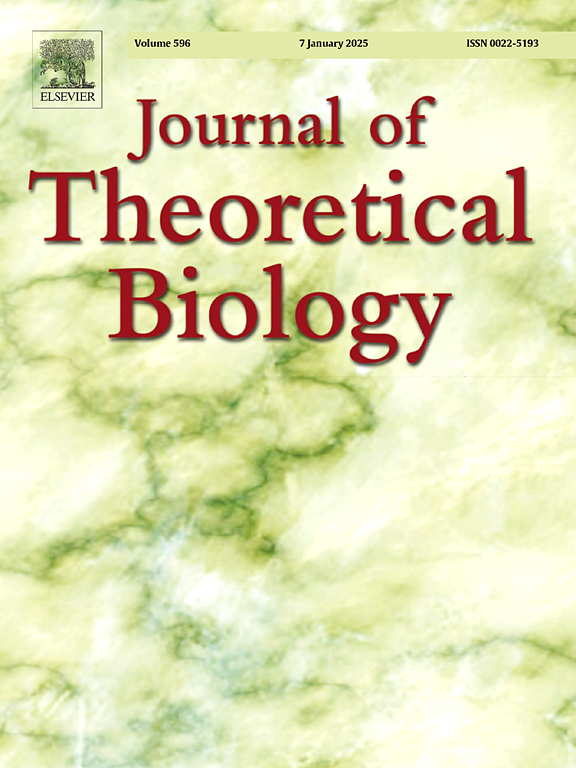单核细胞增生李斯特菌全身性感染的动力学、阈值和机制比较。
IF 1.9
4区 数学
Q2 BIOLOGY
引用次数: 0
摘要
关于单核细胞增生李斯特菌感染的系统规模发病机制的研究一直集中在暴露事件后其在肠道内定植的能力上。然而,尽管如此,许多由单核增生乳杆菌感染引起的最危险的并发症是在暴露后数天、数周或数月后观察到的,这是由于细菌逃离肠道定植中心并入侵其他器官间接造成的。随着时间的推移,在全系统感染期间观察到的各种个体现象的发现已经积累起来,包括肠道传播主要途径的转移,中枢神经系统细菌定植的延迟,跨器官细菌通量的不同以及细菌种群水平的多重稳定性。为了进一步定量了解食源性细菌感染动力学,提出了综合这些发现的全身性感染的室室模型。在BALB/c小鼠感染的参数化下,该模型显示,当控制通过每种途径的细菌数量时,与门静脉相比,通过肠系膜淋巴结传播的细菌数量大幅减少。由于该模型的区隔性,我们预计这一结果可能与其他利用这些途径逃离肠道环境的微生物相似。此外,我们还预测了肠道传播的阈值,这些阈值必须超过才能诱发全身性感染,并描述了这些阈值如何随时间变化。此外,logistic曲线被拟合到合成数据中,作为一种稳健量化肠屏障之外的剂量-反应关系的手段。本文章由计算机程序翻译,如有差异,请以英文原文为准。
Kinetics, thresholds, and a comparison of mechanisms underlying systemic infection by Listeria monocytogenes
Studies on the system-scale pathogenesis of Listeria monocytogenes infection have classically focused on its ability to colonize in the intestines following an exposure event. However, despite this, many of the most dangerous complications arising from L. monocytogenes infection are observed days, weeks, or months after exposure, resulting indirectly from bacteria escaping this intestinal colonization hub and invading other organs. Over time, findings of various individual phenomena observed during systemic infection have accumulated, including a shift away from the principal route of intestinal dissemination, delays in bacterial colonization of the central nervous system, differing bacterial flux rates across organs, and multi-stability of bacterial population levels. To further our quantitative understanding of foodborne bacterial infection dynamics, a compartmental model of systemic infection that synthesizes these findings is proposed. Under parameterization to infection in BALB/c mice, the model is used to show a substantial decrease in bacterial populations resulting from dissemination through the mesenteric lymph nodes, as compared to the portal vein, when controlling for the number of bacteria passing through each route. Due to the compartmental nature of this model, we anticipate that this result may be paralleled in other microbes which make use of these pathways to escape the intestinal environment. Additionally, we predict thresholds for intestinal dissemination along each of these routes, which must be surpassed to induce systemic infection, and describe how these thresholds change over time. Supplementarily, logistic curves are fitted to synthetic data as a means of robustly quantifying the dose–response relationship beyond the intestinal barrier.
求助全文
通过发布文献求助,成功后即可免费获取论文全文。
去求助
来源期刊
CiteScore
4.20
自引率
5.00%
发文量
218
审稿时长
51 days
期刊介绍:
The Journal of Theoretical Biology is the leading forum for theoretical perspectives that give insight into biological processes. It covers a very wide range of topics and is of interest to biologists in many areas of research, including:
• Brain and Neuroscience
• Cancer Growth and Treatment
• Cell Biology
• Developmental Biology
• Ecology
• Evolution
• Immunology,
• Infectious and non-infectious Diseases,
• Mathematical, Computational, Biophysical and Statistical Modeling
• Microbiology, Molecular Biology, and Biochemistry
• Networks and Complex Systems
• Physiology
• Pharmacodynamics
• Animal Behavior and Game Theory
Acceptable papers are those that bear significant importance on the biology per se being presented, and not on the mathematical analysis. Papers that include some data or experimental material bearing on theory will be considered, including those that contain comparative study, statistical data analysis, mathematical proof, computer simulations, experiments, field observations, or even philosophical arguments, which are all methods to support or reject theoretical ideas. However, there should be a concerted effort to make papers intelligible to biologists in the chosen field.

 求助内容:
求助内容: 应助结果提醒方式:
应助结果提醒方式:


